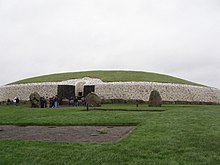Passage tomb
Megalithic systems of several special types are referred to as Passage Tomb on the British Isles . The classic Passage Tomb is a form of the megalithic complex that is characteristic of Northern Ireland and the north of the Republic of Ireland in 219 copies , which also occurs in Leinster and Munster and in a few copies also in Great Britain .
It looks completely different from the passage graves of Nordic megalithic architecture , while there are similarities to some of the Allées Couvertes in France and some of the Portuguese Antas .
Unlike the continental passage grave, which has a lateral access , has the transition leading Passage Tombs axially into a rectangular ( West Torr straight or slightly jutting-or expanding, or cross-shaped in a chamber), polygonal, round, ( English cruciform passage tomb ) - e.g. B. Newgrange in Ireland, Maeshowe on Orkney or Barclodiad y Gawres on Anglesey .
Stalled cairns
It takes its name from the fact that the chamber is divided into two rows of boxes like a stall by thin panels placed on both sides. The type is represented with 60 plants on the Orkney and associated with the Unstan Ware as ceramics . The very short gait is not an essential feature of the Stalled or Orkney-Cromarty-Cairns (OC) subtypes . The chamber itself is rectangular and elongated (e.g. Midhowe Cairn , Unstan Cairn on Orkney).
Maes Howe type (MH)
Well-known cruciform chambers are Knowth and Newgrange in County Meath , Maes Howe in Orkney and Barclodiad y Gawres in Anglesey in Wales . However, the chamber of the Court Tomb of Behy in County Mayo in Ireland is also cruciform. The Calderstones are the only remnants of such a facility in England. Complexes somewhat similar to the northern passage grave - Cotswold Severn Tombs with lateral access - can be found in Wales (e.g. Capel Garmon and Ty Isaf ).
Ireland, Northern Ireland
Irish passage tombs are mostly found individually, but in five places on the island also in cemeteries with up to 60 copies ( Carrowmore and Carrowkeel in County Sligo , Loughcrew and in the Boyne Valley , in County Meath ) and Kilmonaster Middle in County Donegal . The approximately 300 Irish passage tombs owe their name to a corridor up to 40 m long (but mostly much shorter), which ends axially in a chamber. The whole is covered by an oval or round mound, which is usually bordered by curbs. The shape of the chamber is different and differs significantly from the Scottish specimens, which are also called "Passage Tomb".
The Irish Chambers are:
- round, Carnanmore ,
- rectangular, Passage Tomb of Cross (both County Antrim )
- trapezoid, Listoghil in Carrowmore , County Sligo,
- kinked, Knowth County Meath
- Undifferentiated round or aisle-free facilities like Ashley Park in County Tipperary are known as "Simple Passage Tomb".
However, the floor plan is sometimes more complex, with side chambers that start from a more or less emphasized main chamber. One of the two enclosures under the great mound of Dowth , in County Meath, has only one side cell opening from the large circular main room, but the cells are usually paired on either side. Or there are five or more niches arranged like maple leaves. The head niche is on the axis of the corridor. A pair of side cells and an end chamber result in a cruciform plan (e.g. at Newgrange and one of the two chambers in Hill 1 by Knowth). The central chambers of the cruciform types are high and have tholos-like ceiling vaults . They can be quite small, like in Newgrange (approx. 6 m 2 ), but also very large, like in Fourknocks in County Meath, with 6–7 m in diameter approx. 33 m 2 .
Knowth provided evidence that the two basic forms (kink and cross) followed each other, in a sudden departure from the older pattern (Knowth West).
Rock carvings
Some Irish / Northern Irish Passage Tombs have rock carvings , e.g. B .:
- Baltinglass
- Carnanmore (East Torr)
- Dowth North-tomb
- Fourknocks
- Knockmany
- Knowth
- Loughcrew
- Newgrange
- Seefin
- Sess Kilgreen
- Tornant upper
Scotland
In Scotland, Passage Tombs are concentrated in the far north. In Orkney in particular, they replace the so-called Stalled Cairns ( Blackhammer , Midhowe Cairn ), which are managed as a subtype according to the traditional British classification and which are particularly prevalent on Rousay . While the North Scottish Passage Tombs on the main island are initially under round or heel-shaped ( heel-shaped or horseshoe-shaped) hills, they are z. B. at Tulach an tSionnaich and at Camster Long Cairn subsequently built over with long horned stone mounds . The hills typical of Irish court and Scottish Clyde Tombs are called horned or lobster cairns .
Others
Very few Passage Tombs are in England, Wales and the Channel Islands ( La Hougue Bie ).
See also
Web links
literature
- Gabriel Cooney: Space, Place and People: unfolding the role of Irish megalithic tombs. In: KW Beinhauer (Ed.): Studies on Megalithics , 1999, ISBN 3-930036-36-3 , pp. 331-345.
- Glyn Daniel : The megalith builders of Western Europe . Penguin, Harmondsworth et al. 1963 ( Pelican books A 633).
- George Eogan: Aspects of passage tomb settlement in Ireland. In: KW Beinhauer (Ed.): Studies on Megalithics , 1999, ISBN 3-930036-36-3 , pp. 347-360.
- Frances Lynch: Megalithic tombs and Long Barrows in Britain . Shire, Princes Risborough 1997, ISBN 0-7478-0341-2 ( Shire archeology 73).
- Elizabeth Shee Twohig: Irish Megalithic tombs . Shire, Princes Risborough 1990, ISBN 0-7478-0094-4 ( Shire archeology 63).
- Jürgen E. Walkowitz: The megalithic syndrome. European cult sites of the Stone Age (= contributions to the prehistory and early history of Central Europe. Vol. 36). Beier & Beran, Langenweißbach 2003, ISBN 3-930036-70-3 .


